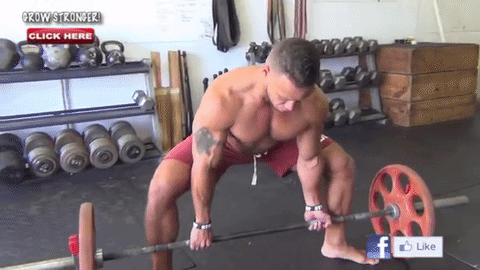The sumo-stance deadlift, or sumo-stance deadlift, is a wide-legged variation of the conventional deadlift. Placing your feet further apart reduces the path the bar has to travel (range of motion, or ROM) and gives yourself a mechanical advantage. And that basically makes it easier to lift more weight.
‘In principle’, because the sumo deadlift is technically a more complex exercise than the conventional one. That is why many people who have switched to the sumo deadlift often switch back to the conventional deadlift after a short time. Like any exercise, the sumo free lift takes time (read: months/years, not days/weeks) to master.
NOT JUST FOR COMPETITIVE ATHLETES
 A widespread misconception is that the sumo deadlift is only suitable for competition powerlifters. That is not true. The sumo deadlift is also a great exercise as such. Many powerlifters train the deadlift both functionally and sumo. There are also plenty of examples of powerlifters who deadlift conventionally in competition, such as Konstantin Konstantinovs. Widely regarded as the greatest powerlifter ever, Ed Coan (pictured) successfully made the transition from conventional to sumo deadlift. Their respective physiques will tell you which type of deadlift is suitable for which type of lifter. Konstantinovs has long limbs, which makes the conventional deadlift more suitable for him. Coan is very stocky, with powerful hips, making the sumo style perfect for him.
A widespread misconception is that the sumo deadlift is only suitable for competition powerlifters. That is not true. The sumo deadlift is also a great exercise as such. Many powerlifters train the deadlift both functionally and sumo. There are also plenty of examples of powerlifters who deadlift conventionally in competition, such as Konstantin Konstantinovs. Widely regarded as the greatest powerlifter ever, Ed Coan (pictured) successfully made the transition from conventional to sumo deadlift. Their respective physiques will tell you which type of deadlift is suitable for which type of lifter. Konstantinovs has long limbs, which makes the conventional deadlift more suitable for him. Coan is very stocky, with powerful hips, making the sumo style perfect for him.
SUMODEADLIFT VS. CONVENTIONAL DEADLIFT
Due to your low hip position, the sumo deadlift is more like a reverse squat than the conventional deadlift. That increases the involvement of your quadriceps. You also start with a fairly straight (vertical) back on the lift, so that the exercise is less taxing on your lower back and you use more ‘hip’. That’s basically the reason your “sumo” is stronger than conventional, not so much the shorter ROM.
With the conventional and the sumo deadlift you use the same muscles, but to a different extent. Both exercises target the erector spinae, which is trained isometrically, but this happens to a greater extent in the conventional deadlift than in the sumo deadlift. The sumo deadlift puts a greater demand on your hip muscles and quadriceps, but the conventional deadlift is again a better exercise for your hamstring, which act as an auxiliary muscle in the top half of the movement, while in the sumo front lift they ‘just’ act as a stabilizer for the entire movement.
Bodybuilders usually opt for the conventional deadlift simply because it “does” the most for overall muscle growth. But those who (forced) want to spare their lower back a bit and/or want to put more emphasis on hips and/or quadriceps, may find the sumo fat lift a great alternative. But again, you have to have a bit of construction for it.
EXECUTION
You perform the sumoread lift with a wide foot position, but not too wide, and your toes out (about 45 degrees). Your ankles should be roughly perpendicular to the floor (see image Ed Coan above), with your knees directly over your ankle joint. With a special deadlift suit, or ‘-suit’ you can afford a wider foot position, but as a ‘raw’ lifter don’t stare at this blindly.
The wide foot position means you grab the bar on the inside of your legs – the second big difference with the conventional deadlift. Rather than bending over, squat to grab the bar.
 Demonstration of the sumoadlift by Elliott Hulse of Strength Camp. (Source: YouTube)
Demonstration of the sumoadlift by Elliott Hulse of Strength Camp. (Source: YouTube)In fact, you do nothing different with the sumo deadlift than with the conventional deadlift: lift the bar off the floor by extending your knees and hips. Anyone who lifts the sumo load for the first time will notice that it is much more difficult to get the bar off the floor. To get the bar off the ground, you have to push your feet out, as it were. Just stand on a towel with your legs spread; that’s what you’re looking for. The tension you feel on the inside of your legs is caused by your potentially inflexible hip adductors.
FINALLY
The sumo deadlift is an ideal way to break deadlift plateaus and strengthen your hip muscles, although the learning curve is steep. You may experience a significant drop in kilograms in the beginning, which actually points to relatively weak hips. If you’re going to deadlift sumo, you certainly don’t have to renounce the conventional deadlift; the two get along just fine in a training program. Cold feet? A good way to get used to the sumo deadlift is to do your warm-up sets ‘sumo’ and your work sets conventional. You can also switch deadlift styles from day to day.
If you’re looking for a good instructional video, check out this YouTube video featuring Mark Bell and the legendary Ed Coan.